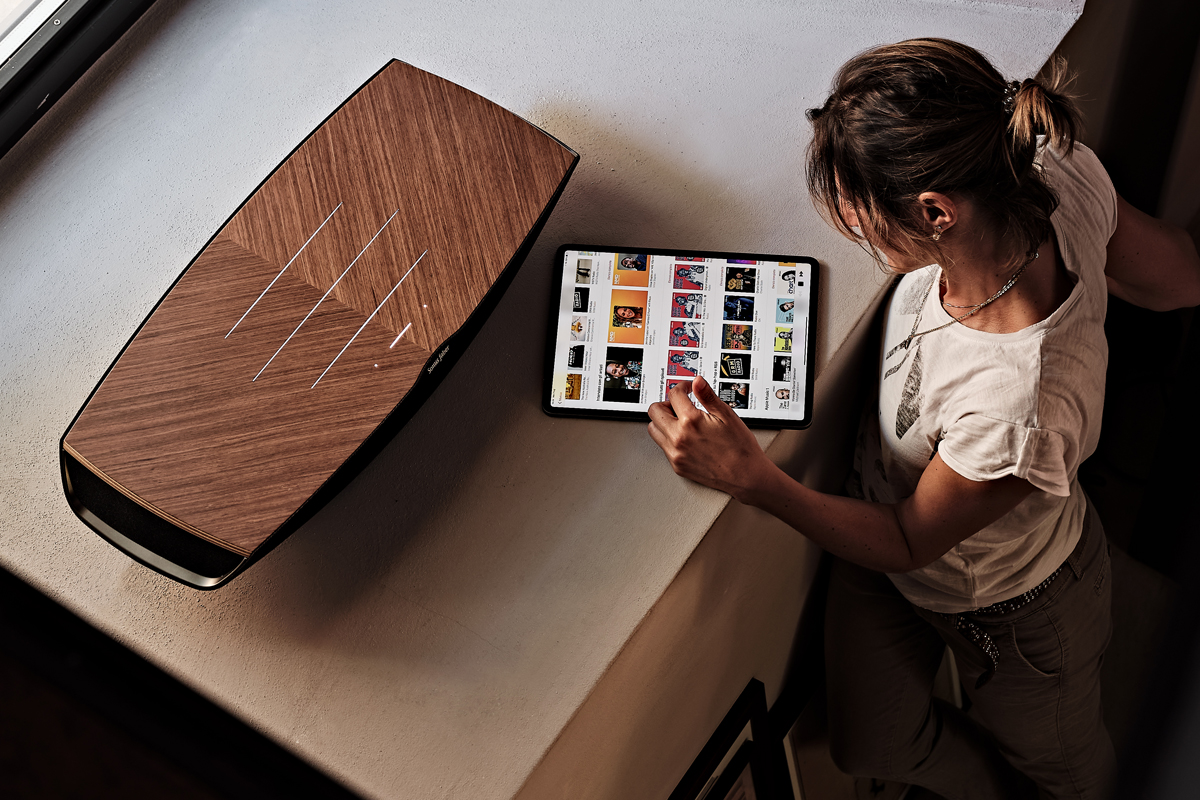The Italian brand Sonus Faber is known for beautifully crafted passive loudspeakers that use luxurious materials, including exotic wood finishes and front baffles with leather inserts. Earlier this year, Sonus Faber announced its Omnia Wireless Music System ($1999, all prices in USD unless noted otherwise). With flowing lines, five-layer veneered walnut top panel, sculpted base, and textured fabric grilles, the Omnia shares the design aesthetic of Sonus Faber’s passive speakers.
Featuring Bluetooth, Wi-Fi, and ethernet connectivity, the Omnia is designed for the streaming era. It supports Apple AirPlay 2, which enables streaming via Wi-Fi from any audio app on an iPhone, iPad, or Macintosh computer. Spotify Connect and Tidal Connect are also supported, so that listeners can cue up music in the apps for those services, and then transfer playback to the Omnia. The Omnia also has Chromecast Built-in, for playback from any Cast-enabled app, and is Roon Ready.
The Omnia has an HDMI input for connection to a television with HDMI ARC port, and an analog audio input that can be switched between line-level and phono operation.
Inside and out
Weighing a shade under 17 pounds and measuring 26″W × 5″H × 11″D, the Omnia is available in Walnut and Graphite finishes. My review sample had the Walnut finish and it looked gorgeous. The wood top panel is divided down the center and the two pieces are seamlessly joined. The satin-finished walnut pieces have a tight grain pattern whose lines run diagonally downward toward the center, forming a dramatic V pattern. From the side, you can discern the top panel’s five layers.
The Graphite model has the same five-layer top panel as the Walnut version, Livio Cucuzza, chief of industrial design, told me in a Zoom interview. But in the Graphite version, a black wash is applied, giving it an industrial look. Cucuzza pointed out that up close, the V-shaped grain pattern is clearly visible.
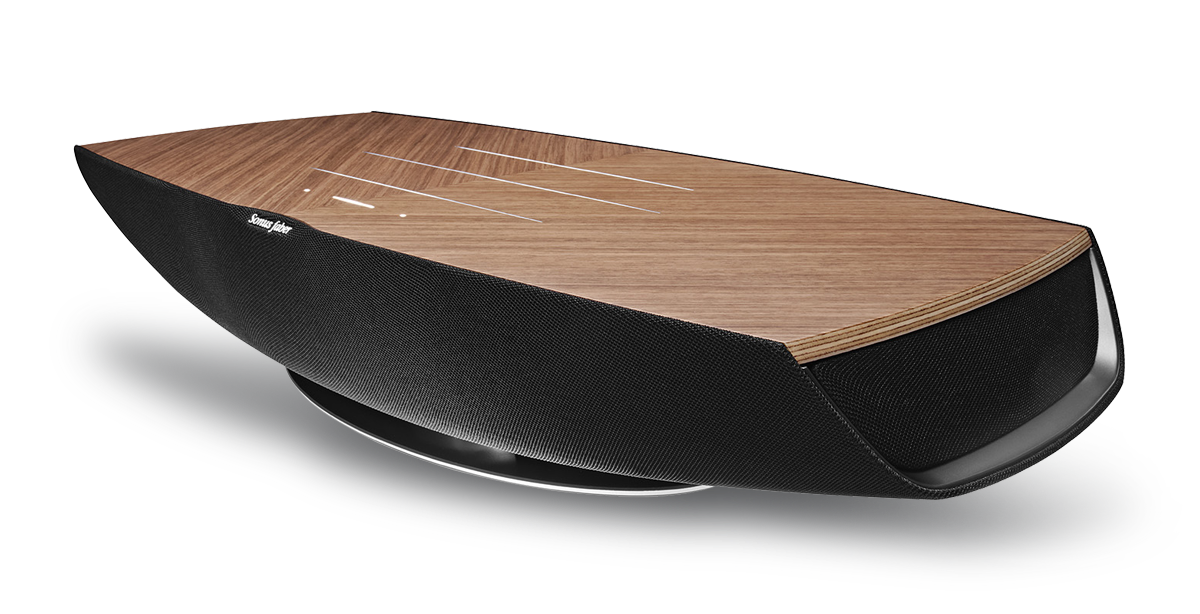
On both versions, the front, rear, bottom, and sides are covered in black woven cloth. The side grilles are surrounded by dark-gray accent pieces. The Omnia sits on a dark-gray, sculpted base, which is illuminated from above by blue-white LEDs when music is playing.
Nestled into the rear of the Omnia’s base is a jack pack with a reset button, two-prong power connector, HDMI input, LAN port, six-pin DIN analog input, and a two-position analog selector switch with phono and line-level settings. The Omnia ships with a DIN-to-RCA adapter cable. In addition to RCA jacks, the adapter has a ground screw for use with a turntable.
Unlike many digital music players, the Omnia does not use an alphanumeric display to present information and menu options. Instead, its Senso™ interface uses LEDs on the top panel. At the front are three touch controls—two dots flanking a short stripe that Sonus Faber calls a Control Line. Touch the dot on the left to lower the volume, and the one on the right to raise it. Tap the Control Line to pause and resume playback; press, hold, and release the Control Line to turn the Omnia on and off. The Control Line changes color depending on the selected source: blue for Bluetooth, orange for HDMI, pink for phono/line-level analog, white for AirPlay, yellow for Chromecast, green for Spotify Connect, turquoise for Tidal Connect, and purple for Roon.
Above the Control Line are three Feedback LED strips. When you lower volume, the illuminated region of the LED strip immediately above the Control Line narrows; when you raise volume, it widens.
A small remote control is included with the Omnia, with buttons for power on/off, volume up/down, mute, play/pause, previous and next track, source selection, and turning the Omnia’s LEDs off and on. The remote, which is the same shape as the player it controls, has a pleasing, rubberized feel.
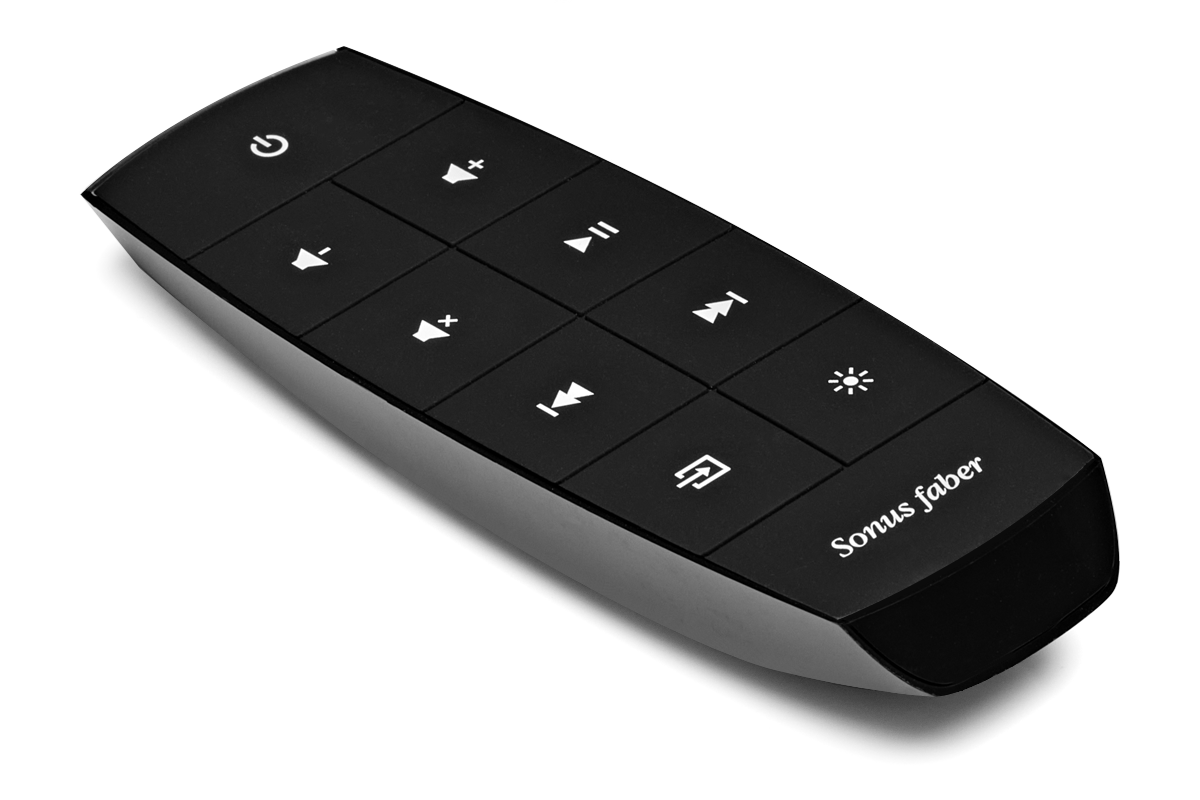
On the outer edges of the front panel are two 0.75″ silk-dome tweeters, one for each channel, and two 3″ midrange drivers with paper pulp cones—these are angled slightly downward. Low frequencies are produced by a single shared 6.5″ woofer that fires downward into the base. Behind each side grille is a 1.75″ full-range driver that is used for Crescendo™ processing—more on that later.
Powering the drivers are eight identical class-D amplifiers. The woofer is powered by two amplifier modules in bridged mode. Sonus Faber does not specify the power output delivered to each driver, but rates total power output at 490W, and maximum SPL at 108dB. Maximum resolution for datastreams received via ethernet or Wi-Fi is 32-bit/192kHz.
In addition to implementing the crossover, the Omnia’s digital signal processor time-aligns the drivers and applies EQ to optimize frequency response. The DSP also implements a bass excursion control that prevents the woofer from being overdriven, and an option to compensate for situations when the Omnia is located too close to a wall. And it runs the company’s Crescendo™ processing, which sends delayed sound to the side-mounted full-range drivers to create a combination of dipole and bipole behaviors. The effect is to broaden and heighten the soundstage. As you’ll read later, I really liked what Crescendo™ processing did to the Omnia’s sound.
Setup and software
The rudimentary Quick Start Guide outlines two methods for connecting the Omnia to your Wi-Fi network: one for iOS devices, the other for Android devices. I ran into complications while trying to connect the player to my Google Wifi mesh network.
Owners of iOS devices should use Apple’s Home app to set up the Omnia, the Guide states. Launch the Home app, tap the + icon to add an accessory, and follow the instructions in the app. But when I ran the Home app on my iPhone 8, the app did not find the Omnia, so I could not proceed.
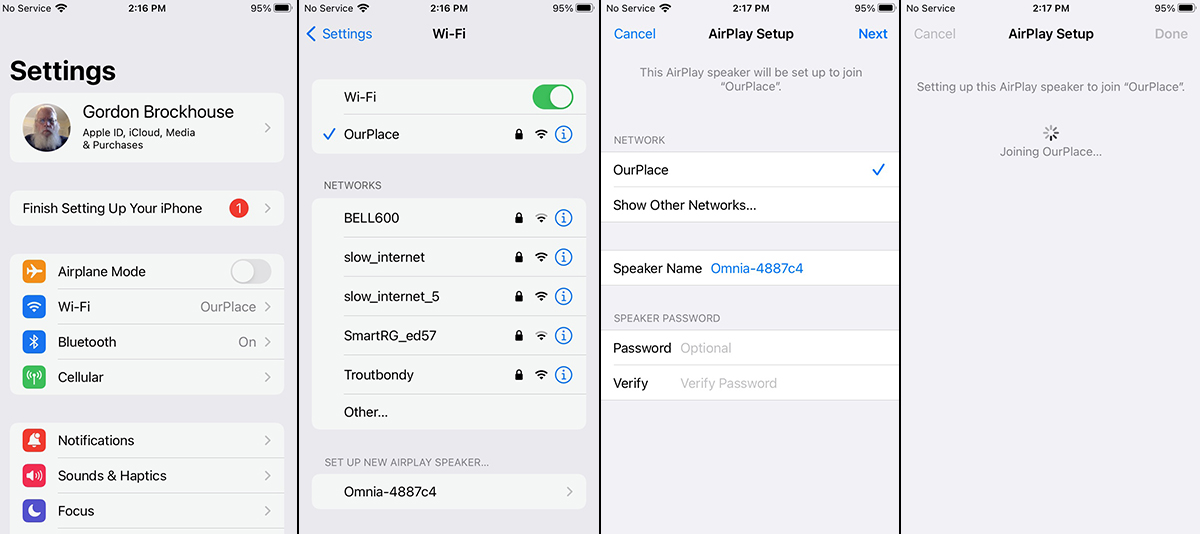
At the bottom of Sonus Faber’s web page for the Omnia, there’s a setup video and an interactive manual. These resources provided a different set of instructions for iOS users. Following those setup instructions, I selected the Omnia as an AirPlay speaker in my iPhone’s Wi-Fi settings, and I was prompted to connect the Omnia to the same network that my phone was using. A couple of seconds later, the Omnia was connected. Easy-peasy.
After setting the Omnia up on my iPhone, it did not appear as a device in Google Home on my iPhone or my Google Pixel 4a Android phone. It did appear in Roon as a Roon Ready and AirPlay device, but not as a Chromecast device. I could stream to it directly from my iPhone via AirPlay, and also play music via Spotify Connect and Tidal Connect. This is normal—if you want to stream to a device via Chromecast, that device must be set up in the Google Home app. As expected, setting up the Omnia with Google Home and Device Utility on my Pixel phone, my iPhone saw the device as an AirPlay speaker. It appeared in Roon as a Roon Ready device, AirPlay device, and Chromecast device. I could use Spotify Connect and Tidal Connect, and could also transfer playback to the Omnia from any Cast-enabled app.
I had also run into complications setting up the Omnia using the Google Home app on my Google Pixel 4a smartphone. Per the Quick Start Guide, I launched the Google Home app, and chose the option to set up the Omnia that appeared near the top of the screen. Google Home found the Omnia but displayed a message saying the device “needs to be activated before setup.” This was the first time I’d seen that message when setting up Chromecast devices with Google Home.
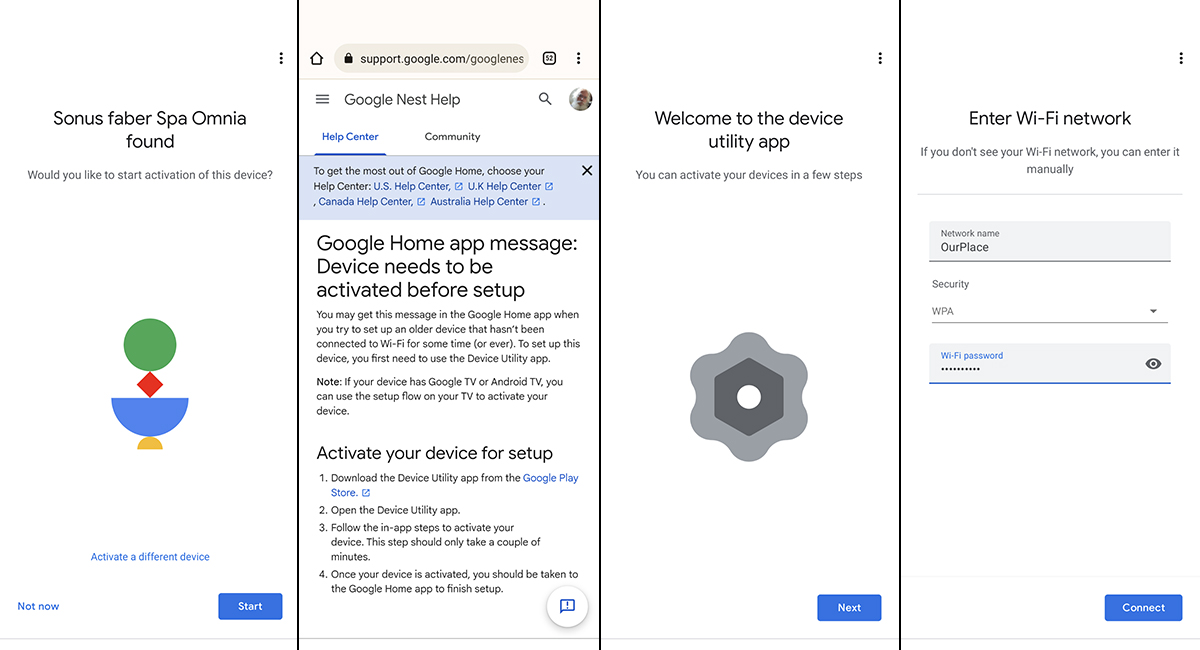
Not knowing how to perform this step, I asked for help. The Google support page informed me that this message may appear “when you try to set up an older device that hasn’t been connected to Wi-Fi for some time (or ever). To set up this device, you first need to use the Device Utility app.”
So, I downloaded Device Utility from Google Play. The app instructed me to turn off Wi-Fi on my phone. That step complete, Device Utility found the Omnia, and asked if I wanted to start activation. Yes, please. The app established communication with the Omnia, and played a sound through it, confirming it was connected. In the next screen, it asked me to choose the network I wanted to use, but did not display a list of available networks, so I had to enter my network name and password manually. Not only that, I had to guess what type of security key (WEP, WPA, WPA2) my network used. After I entered my network info, the Device Utility app connected the Omnia to my home network, prompted me to enable Wi-Fi on my smartphone, then kicked me back to the Google Home app. Google Home looked for the Omnia, but could not seem to find it. But when I canceled the search, the Omnia was there at the bottom of the Google Home screen, waiting to be assigned to a room. Kinda sloppy, but it worked in the end.
Since completing this review, I’ve had similar problems setting up other Chromecast-enabled devices with the Android version of Google Home—but the iOS version of Google Home works fine. I suspect that something got broken in recent updates to the Android OS and/or the Android version of Google Home. If that’s the case, hopefully Google will fix this soon.
The back of the warranty card lists a third way of setting up the Omnia: using the player’s web-based interface. When you scan the QR code on the card with your mobile device, you’ll see a message offering to browse to the product’s web page. But when I tried that, with either of my phones, I got an error message saying the web page was not available.
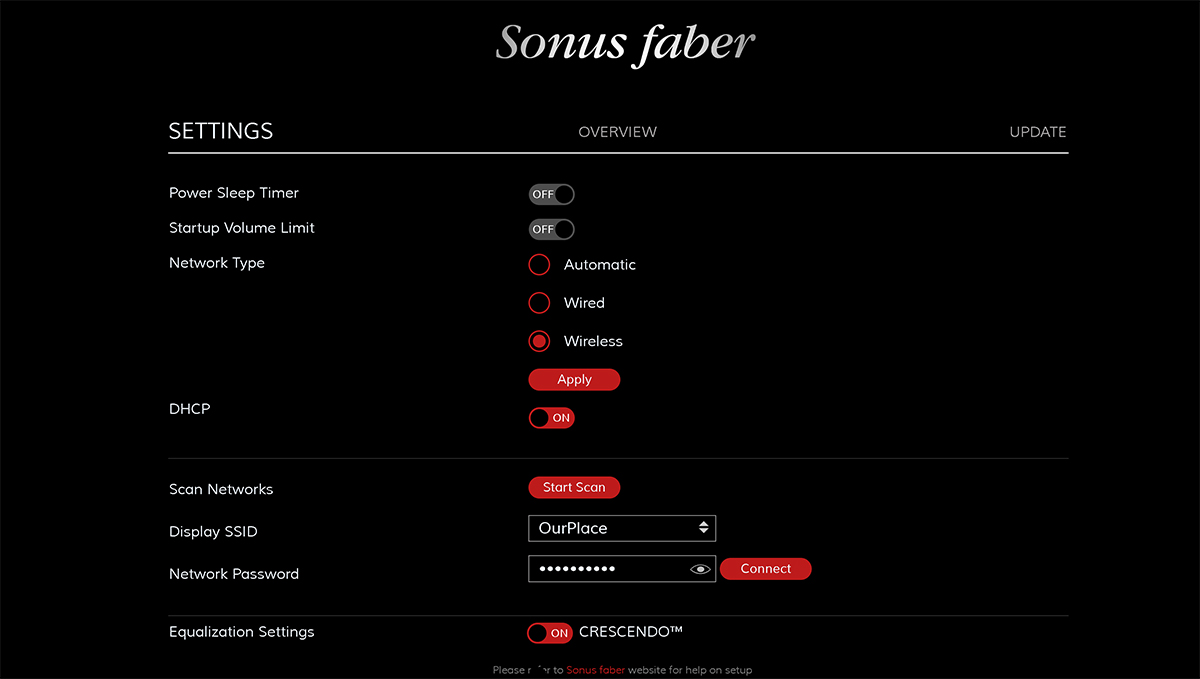
The correct way to use the Omnia’s web-based setup page is outlined in the interactive manual. Go into the network settings of your computer or mobile device and select the hotspot network created by the Omnia, then enter the Omnia’s IP address (192.168.255.249) in your web browser. That will take you to the Omnia’s web interface, where you can scan for available Wi-Fi networks. Select yours and enter your password. I followed this process, and it worked perfectly.
If you use web-based setup, Chromecast will not be enabled; but AirPlay 2, Spotify Connect, Tidal Connect, and Roon will all work fine. To enable Chromecast, you have to add the Omnia to your Google Home, as described earlier.
After setting up the Omnia with iOS, Google Home, or the web interface, I could scan the QR code on the warranty card to be taken to the web interface. Alternatively, I could access the interface via the IP address assigned to the Omnia by my Wi-Fi router. The IP address is shown in the information for the Omnia in the Google Home app, and can be entered in a browser on a PC, Mac, smartphone, or tablet connected to the same network as the Omnia.
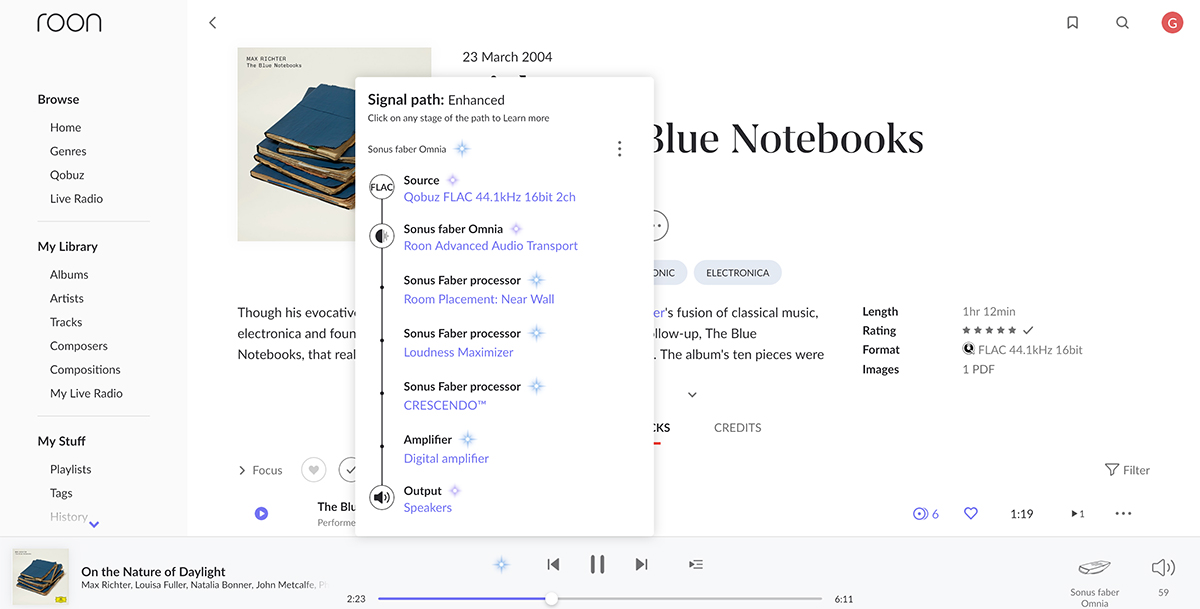
The web interface lets you perform functions like enabling and disabling Crescendo™ processing and choosing the Room Placement setting (Near the Wall or Away from the Wall). I spent some time experimenting with those settings.
When Crescendo™ was activated (the default setting), the soundstage was a few feet wider than the Omnia, and a foot or so higher, and specificity of aural images was quite precise. When I disabled Crescendo™, the soundstage collapsed to the outer dimensions of the Omnia. The sound was a tad less incisive with Crescendo™ turned on, but only a tad, and that was the only downside. I heard no artifacts that would indicate that there was some DSP trickery going on; I just noticed bigger, more immersive sound. I doubt any Omnia owner will want to disable this feature, so I did all my listening with Crescendo™ enabled.
Bass performance was excellent for an all-in-one tabletop system: full, deep, and tactile. But with the Omnia placed on the mantle in our living room, the lowest double bass and electric bass-guitar notes were a bit boomy. I experimented with the two Room Placement settings in the web interface. While bass was slightly more robust with the default Away from the Wall setting, it had more texture with the Near the Wall setting; and this is what I used for most of my listening.
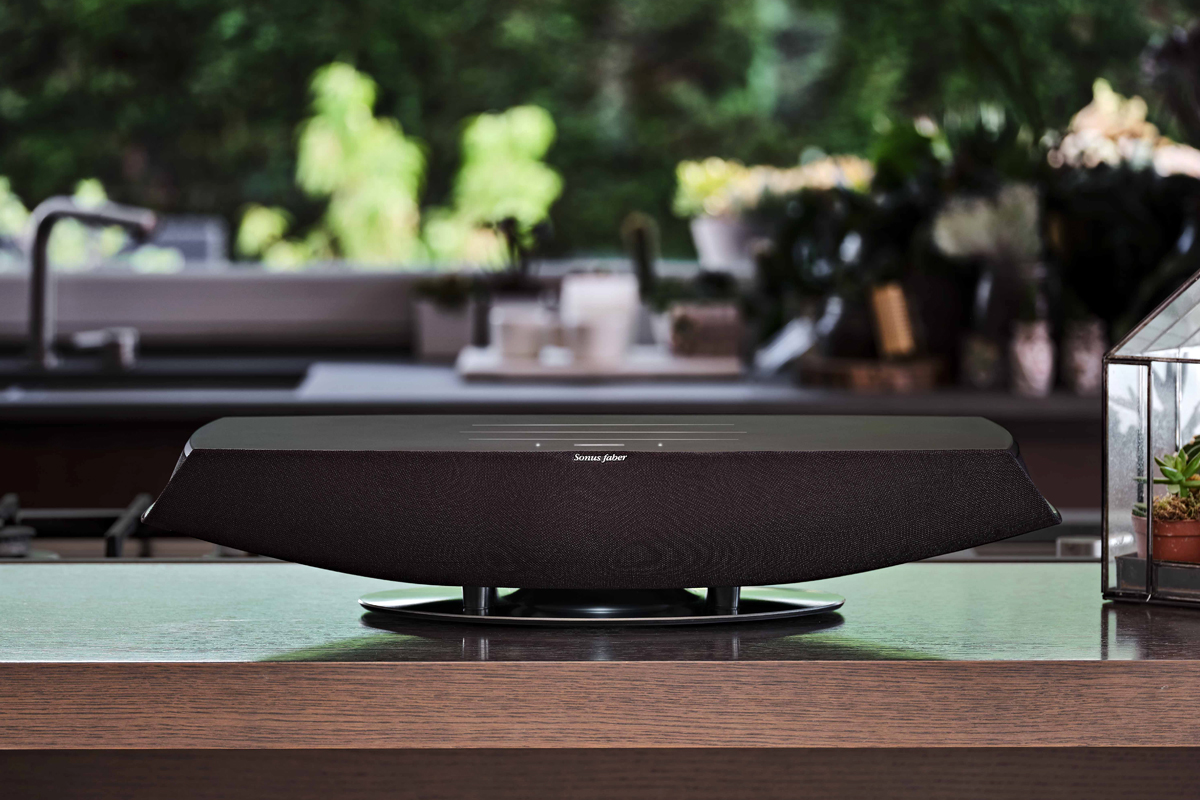
There was enough output from that down-firing woofer to rattle the knickknacks and candlesticks my wife keeps on the mantle, so I removed them. The woofer also caused the electric fireplace’s innards to buzz slightly. Placing a couple of paperbacks between the Omnia and mantle solved that problem. Don’t take this as a criticism of the Omnia, but rather a testament to its surprising bass output—and a caution that users should be sure to place the Omnia on a rigid surface.
The browser interface also has a control called Loudness Maximizer, which applies a slight bass boost at low volumes. It has no effect at normal listening levels. I left this feature engaged—the default setting.
Listening
Placed on the mantle of the electric fireplace in our living room, the Omnia was 6.5″ from the wall behind it, and 7′ from my main listening position on the end cushion of our sectional sofa on the opposite wall, where I did most of my listening. As the Omnia is a lifestyle product meant for casual as well as serious listening, I also wandered around the room while music was playing.
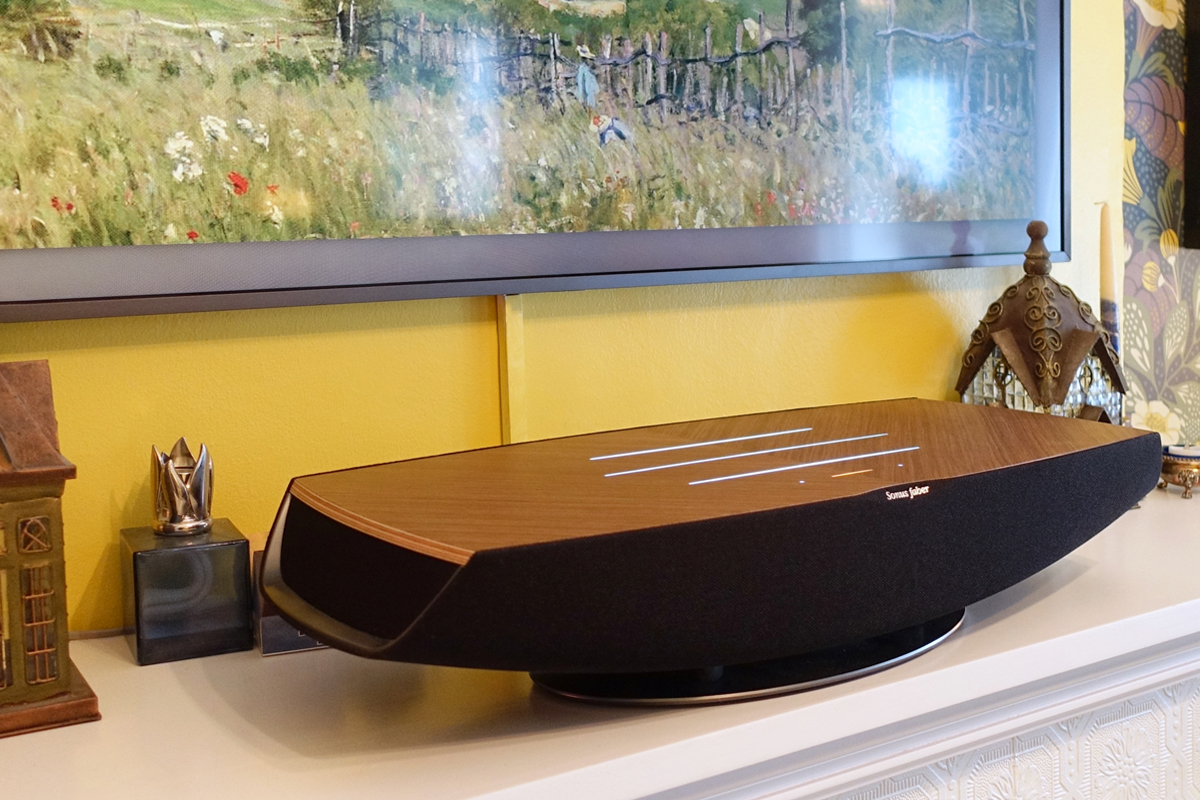
For analog playback, I connected my Pro-Ject Debut Carbon Evo turntable ($799 CAD with preinstalled Ortofon 2M Red cartridge). With the volume control set halfway, I could hear mild hiss with my ear next to one of the Omnia’s tweeters. More than a few feet away, noise was inaudible.
The first record I spun was Cécile McLorin Salvant’s wonderful new album Ghost Song (Nonesuch Records 075597914665). In “Thunderclouds,” Salvant’s soprano voice floated about a foot above the Omnia. Her voice sounded completely natural throughout her entire range—I noticed no coloration at all. The Omnia made it easy to visualize the way she formed words. Consonants were clear, but not the least bit hot or spitty.
Salvant’s piano phrases had lovely clarity in the middle and high octaves, and satisfying heft in the low octaves. Likewise, Marvin Sewell’s electric guitar was wonderfully clear. During his solo, I could visualize the way he bent strings to shift pitches. While the lowest notes of Burniss Travis’s double bass sounded a bit fat, they also had good detail and texture. Pizzicato attacks were clear, but not exaggerated, and segued smoothly into the resonance of his instrument, providing a warm foundation to this lovely Salvant composition.
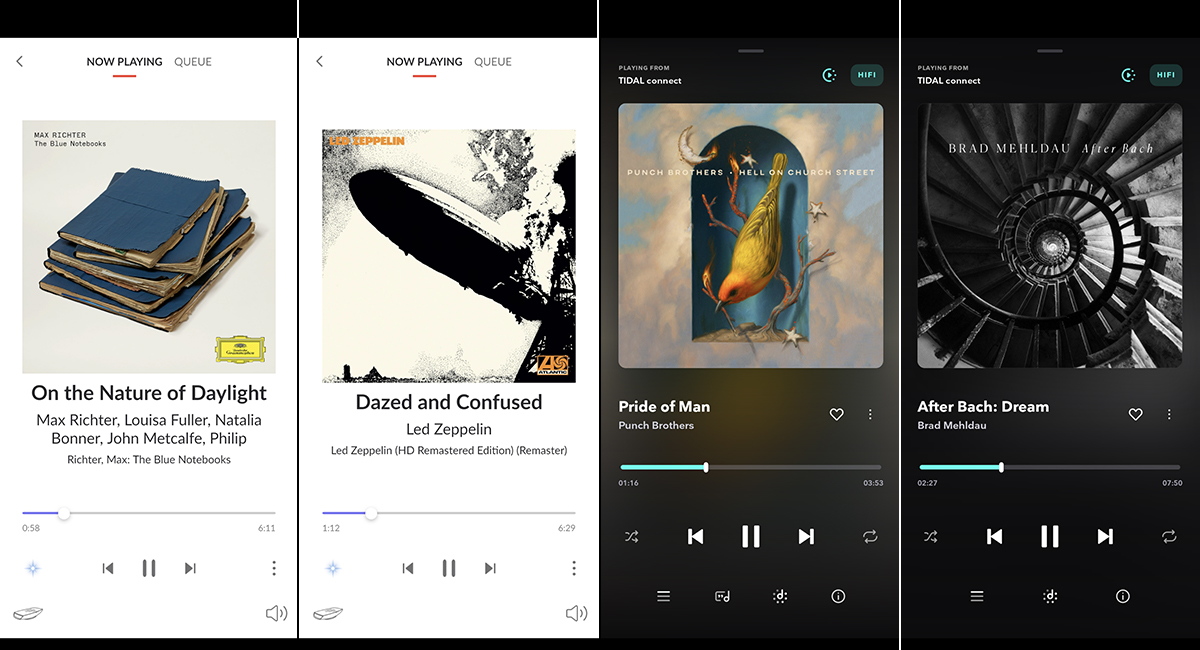
Next, I streamed Max Richter’s meltingly beautiful “On the Nature of Daylight” from The Blue Notebooks (16-bit/44.1kHz FLAC, Deutsche Grammophon / Qobuz) to the Omnia from my Apple Mac Mini, which runs Roon Core 1.8 music-management software. The tonalities of each of the five string instruments were wonderful. The two cellos were rich and woody, the two violins warm and silvery. In the opening passage, the viola sounded almost human.
Given the Omnia’s design aesthetic, which evokes a musical instrument, and the fact it originates in the country of Amati, Guarneri, and Stradivari, you’d probably expect it to deliver gorgeous string tone. But, like me, you might be taken aback by the Omnia’s rendition of Richter’s Moog synthesizer, which enters at the same time as the violins, after the opening theme played by violist John Metcalfe. Those deep—almost subterranean—notes were full and intense, with excellent pitch differentiation.
Wanting to hear how the Omnia would deal with something more rambunctious, I cued up “Dazed and Confused” from the remastered HD version of Led Zeppelin’s self-titled debut album (24/96 FLAC, Atlantic Records / Qobuz).
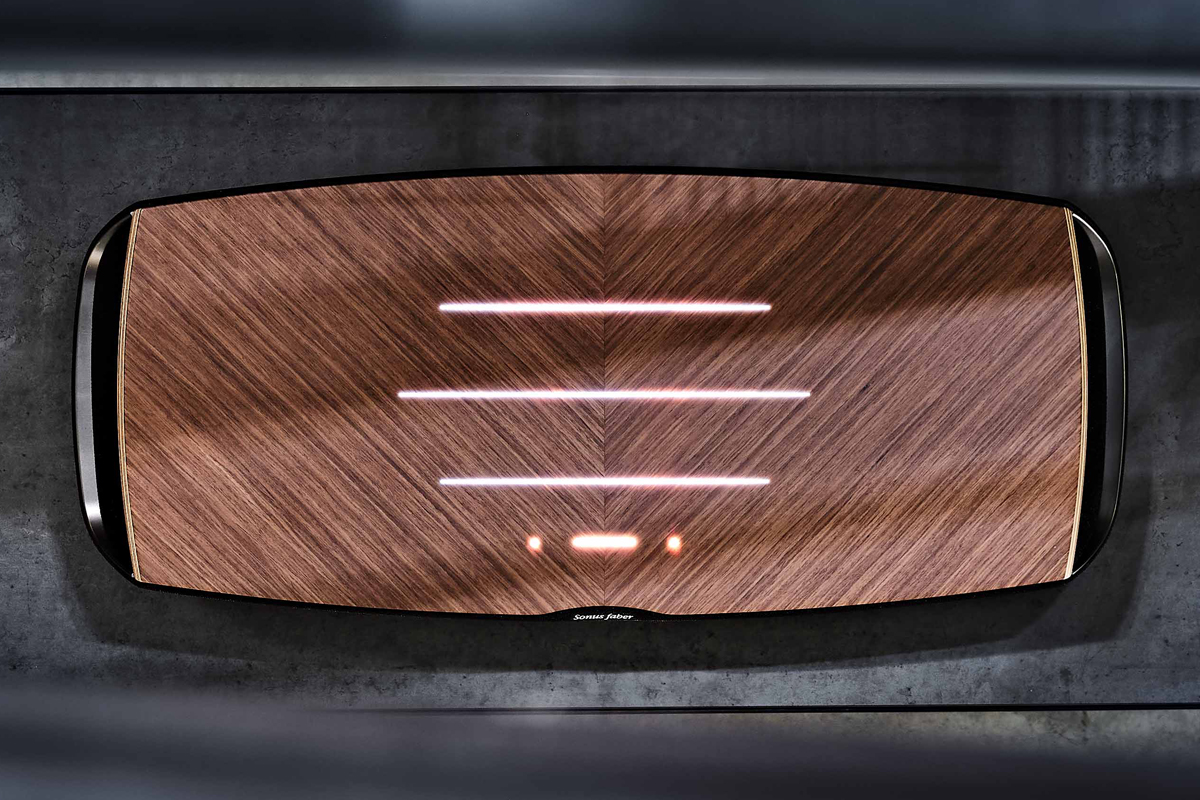
The Omnia nailed John Paul Jones’s descending bluesy electric-bass riff, which underpins most of the track. Right down to the lowest notes, it sounded big and impactful, but also well controlled—his plucks were fast and crisp, not sluggish. Likewise, John Bonham’s furious kickdrum beats and floor-tom rolls just pounded, and Jimmy Page’s distorted electric guitar shredded. I loved the way the Omnia tracked Robert Plant’s agonized wailing, showcasing his expressive delivery and dynamic shading. With the volume set just low enough to avoid upsetting our neighbors, the Omnia delivered the frenetic instrumental section in the middle of the track without a hint of distress.
To play movies and TV shows, I connected the Omnia’s HDMI input to the HDMI ARC port of the One Connect breakout box for my 55″ Samsung Frame TV, which is mounted on the wall immediately above the fireplace. The TV recognized the Omnia as an HDMI audio receiver and set it as the audio output device. Among other benefits, this let me control the Omnia’s volume setting with the Frame TV’s remote.

Streaming the first episode of the HBO miniseries The White Lotus, which is set in a Hawaiian resort, I was wowed by the way this all-in-one system reproduced to the low-pitched percussion instruments in Cristobal Tapia de Veer’s tropical theme music. They sounded deep and impactful, though a little lacking in texture. With Crescendo™ engaged, the Omnia threw a soundstage that extended to the edges of the TV screen, and almost to the top—in other words far beyond the outer dimensions of the Omnia. Female voices sounded natural, but male voices (particularly Jake Lacy as Shane Patton) were a bit chesty. With both male and female voices, sibilants were clear but never hot, so that dialog was completely intelligible. Foley effects such as crashing waves were very convincing. There was no hint of the edginess or hardness that one often hears with soundbars.
Comparison
A natural comparison for the Omnia is Naim Audio’s Mu-so 2nd Generation ($1799). The Mu-so has a dome tweeter, a midrange driver, and an oval woofer for each channel. Each driver is powered by its own 75W class-D amplifier, for a total output of 450W. Like the Omnia, the Mu-so supports Apple AirPlay 2, Chromecast, Spotify Connect, and Tidal Connect. It has HDMI ARC, TosLink S/PDIF, and 3.5mm stereo line-level inputs, but no phono preamplifier. However, the Naim player has a USB Type-A port for connecting an external drive containing music files.
Trutone Electronics of Mississauga, Ontario, kindly allowed me to spend a couple of hours in the store’s showroom comparing my Omnia review sample with a Mu-so demo unit. For this comparison, I used the Omnia’s Away from the Wall room-boundary setting and the Mu-so’s No Compensation setting, as both players were positioned 24″ away from the wall.
After connecting the Omnia to Trutone’s store network, I streamed Punch Brothers’ cover of Hamilton Camp’s “Pride of Man” from the band’s new album Hell on Church Street (16/44.1 FLAC, Nonesuch Records / Tidal) to the two players via Tidal Connect. Chris Eldridge’s acoustic guitar sounded a little richer and woodier through the Omnia, and its steel strings rang more beautifully. Paul Kowert’s double bass sounded fuller through the Omnia, but low notes were thuddier, perhaps because the Omnia’s down-firing woofer was exciting the equipment cabinet that the two players were sitting on. I preferred the way Naim player rendered Chris Thile’s slightly nasal tenor—his voice had more presence. Through the Omnia, it was more recessed. The same was true of Gabe Witcher’s fiddle. The Omnia threw a bigger soundstage, creating a more immersive experience. Overall, the Omnia sounded fuller and warmer, the Mu-so clearer and more incisive.
On “Dream” from After Bach, by jazz pianist Brad Mehldau (16/44.1 FLAC, Nonesuch Records / Tidal), the Mu-so was more articulate, so that I could better appreciate Mehldau’s touch. But piano tone was heftier and more authoritative in the lower octaves through the Omnia, so it conveyed the power of Mehldau’s Steinway grand more convincingly. However, those low notes sounded thuddier; as noted before, that may have been because the woofer was exciting the cabinet that supported the two players. Thanks to its Crescendo™ processing, the Omnia created a larger, more immersive presentation than the Mu-so.
Conclusion
I’ve picked some sizable nits about the Omnia’s setup process, which is messier than it should be. But purchasers of the Omnia can avoid most setup hassles if they pitch the inaccurate Quick Start Guide and instead rely on the online interactive manual and video tutorial, both of which are available on Sonus Faber’s website. And of course, setup is a one-time process—when it’s done, it’s done. In day-to-day operation with Roon, AirPlay 2, Chromecast, Spotify Connect, and Tidal Connect, everything worked fine.
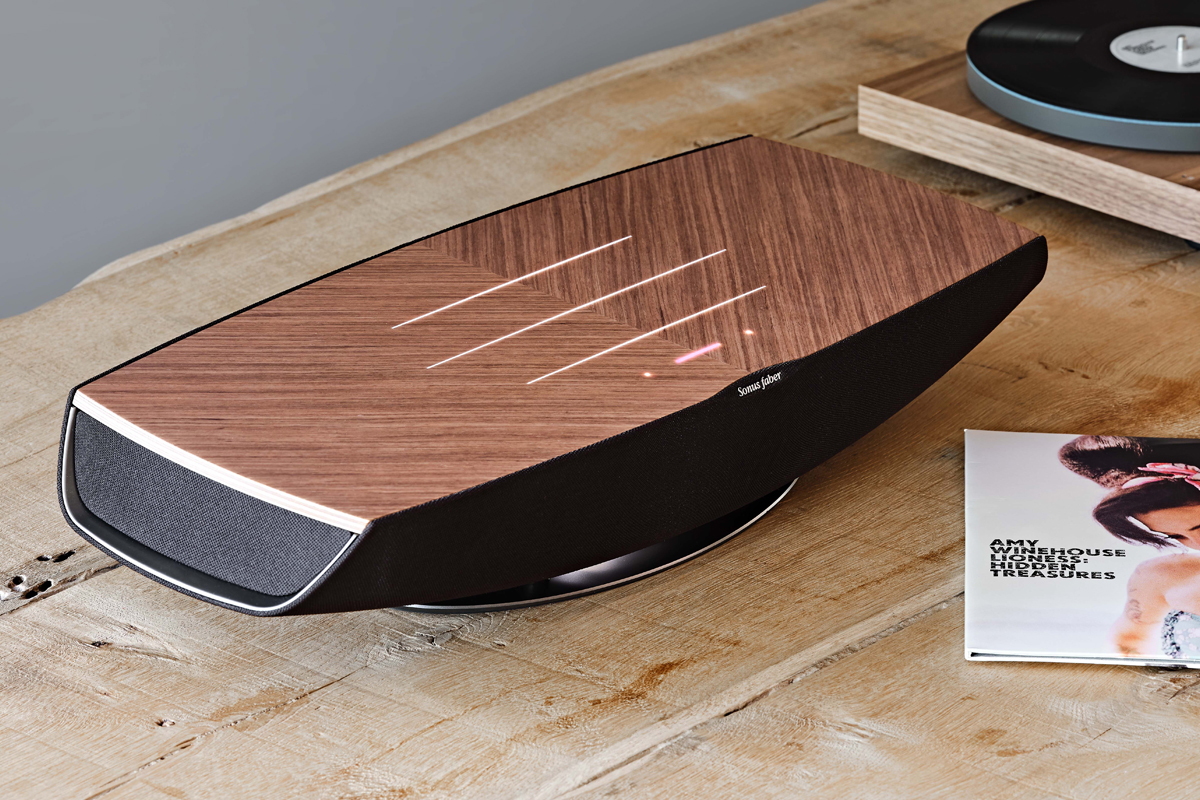
As to the sound of the Omnia, I had no reservations. During my listening, the Omnia could be warm and lyrical, as it was when playing Salvant’s “Thunderclouds” and Richter’s “On the Nature of Daylight.” When called upon, it could also kick ass, as it did with “Dazed and Confused” by Led Zeppelin. With everything I played, Crescendo™ processing created a soundstage that was considerably wider and higher than you’d expect from an all-in-one music system.
And let’s not forget the gorgeous Italian design. The Omnia is a work of art, visually as well as sonically.
. . . Gordon Brockhouse
Associated Equipment
- Sources: Apple Mac Mini running Roon Core 1.8, Pro-Ject Debut Carbon Evo with Ortofon 2M Red Cartridge, Samsung UN55LS003 55″ UHD TV “The Frame.”
- Music player: Naim Audio Mu-so 2nd Generation.
- Control devices: Google Pixel 4a 5G smartphone running Android 12, Apple iPhone 8 running iOS 15.4, HP Spectre x360 convertible notebook PC running Windows 11.
- Network: Google Wifi four-node mesh network.
Sonus Faber Omnia Wireless Music System
Price: $1999.
Warranty: Three years, parts and labor.
Sonus Faber SpA
Via Antonia Meucci 10
36057 Arcugnano (VI)
Italy
Phone: (39) 0444-288788
Website: www.sonusfaber.com
